
The Royal Horticultural Society (RHS), founded in 1804 as the Horticultural Society of London, is the UK's leading gardening charity.

Agapanthus is the only genus in the subfamily Agapanthoideae of the flowering plant family Amaryllidaceae. The family is in the monocot order Asparagales. The name is derived from Greek: ἀγάπη, ἄνθος.

Tulbaghia is a genus of monocotyledonous herbaceous perennial bulbs native to Africa, belonging to the Amaryllis family. It is one of only two known genera in the society garlic tribe within the onion subfamily. The genus was named for Ryk Tulbagh (1699–1771), one time governor of The Cape of Good Hope.

Alstroemeria, commonly called the Peruvian lily or lily of the Incas, is a genus of flowering plants in the family Alstroemeriaceae. They are all native to South America although some have become naturalized in the United States, Mexico, Australia, New Zealand, Madeira and the Canary Islands. Almost all of the species are restricted to one of two distinct centers of diversity, one in central Chile, the other in eastern Brazil. Species of Alstroemeria from Chile are winter-growing plants while those of Brazil are summer-growing. All are long-lived perennials except A. graminea, a diminutive annual from the Atacama Desert of Chile.
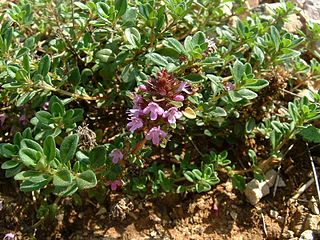
Thymus serpyllum, known by the common names of Breckland thyme, Breckland wild thyme, wild thyme, creeping thyme, or elfin thyme, is a species of flowering plant in the mint family Lamiaceae, native to most of Europe and North Africa. It is a low, usually prostrate subshrub growing to 2 cm (1 in) tall with creeping stems up to 10 cm (4 in) long. The oval evergreen leaves are 3–8 mm long. The strongly scented flowers are either lilac, pink-purple, magenta, or a rare white, all 4–6 mm long and produced in clusters. The hardy plant tolerates some pedestrian traffic and produces odors ranging from heavily herbal to lightly lemon, depending on the variety.
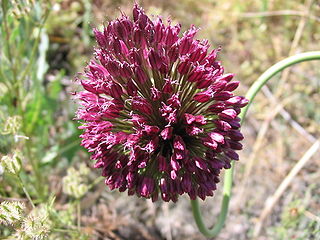
Allium sphaerocephalon is a plant species in the Amaryllis family known as round-headed leek and also round-headed garlic, ball-head onion, and other variations on these names. Other names include Drumsticks, and in Germany, Kugellauch. Some publications use the alternate spelling A. sphaerocephalum. It is a hardy perennial plant.
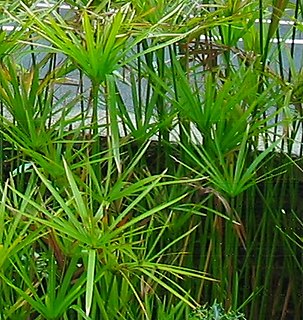
Cyperus alternifolius, the umbrella papyrus, umbrella sedge or umbrella palm, is a grass-like plant in the very large genus Cyperus of the sedge family Cyperaceae.
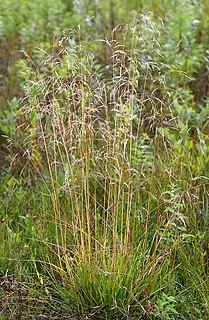
Deschampsia cespitosa, commonly known as tufted hairgrass or tussock grass, is a perennial tufted plant in the grass family Poaceae. Distribution of this species is widespread including the eastern and western coasts of North America, parts of South America, Eurasia and Australia.
Division, in horticulture and gardening, is a method of asexual plant propagation, where the plant is broken up into two or more parts. Both the root and crown of each part is kept intact. The technique is of ancient origin, and has long been used to propagate bulbs such as garlic and saffron. Division is mainly practiced by gardeners and very small nurseries, as most commercial plant propagation is now done through plant tissue culture.

RHS Garden Hyde Hall is a public display garden run by the Royal Horticultural Society in the English county of Essex. It is one of five public gardens run by the Society, alongside Wisley in Surrey, Harlow Carr in North Yorkshire, Rosemoor in Devon, and Bridgewater in Greater Manchester.

Sparrmannia africana, the African hemp or African linden, is a species of flowering plant in the family Malvaceae, native to open woodland in Africa, South Africa and Madagascar. It is one of up to seven species in the genus Sparrmannia. The genus name is after Anders Sparrman.

Allium moly, also known as yellow garlic, golden garlic and lily leek, Is a species of flowering plant in the genus Allium, which also includes the flowering and culinary onions and garlic. A bulbous herbaceous perennial from the Mediterranean, it is edible and also used as a medicinal and ornamental plant.

RHS Garden Rosemoor is a public display garden run by the Royal Horticultural Society in north Devon, England.
Penelope Hobhouse MBE, née Chichester-Clark, is a British garden writer, designer, lecturer and television presenter.

Tulbaghia violacea, known as society garlic is a species of flowering plant in the family Amaryllidaceae, indigenous to southern Africa, and reportedly naturalized in Tanzania and Mexico.
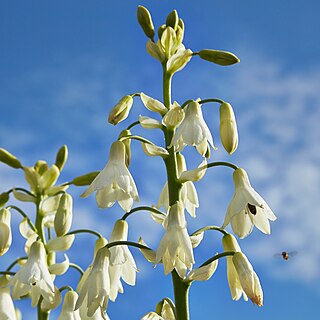
Ornithogalum candicans, known as the summer hyacinth, is a species of flowering plant in the family Asparagaceae, native to moist grassland in South Africa. It is a bulbous perennial growing to 100–120 cm (39–47 in), with strap-shaped leaves and white snowdrop-like flowers in late summer. It is still widely referenced under its synonym Galtonia candicans. Originally it had been designated as Hyacinthus candicans, by Baker in 1870.
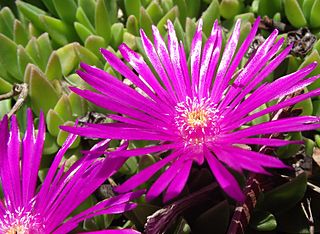
Delosperma lavisiae is a species of flowering plant in the family Aizoaceae, native to South Africa and Lesotho. It goes by a number of common names relating to its habitat, growing as high as 2,650 m (8,700 ft) up in the Drakensberg mountains; Drakensberg ice plant, Drakensberg vygie, and mountain vygie. A mat‑forming, cold hardy succulent, able to withstand occasional frosts as low as −20 to −15 °C, it has gained the Royal Horticultural Society's Award of Garden Merit.
Oxalis melanosticta, the black-spotted wood sorrel, is a species of flowering plant in the family Oxalidaceae, native to the southwestern Cape Provinces of South Africa. Its cultivar 'Ken Aslet' has gained the Royal Horticultural Society's Award of Garden Merit.
Tulbaghia natalensis, called pink wild garlic and sweet wild garlic, is a species of flowering plant in the family Amaryllidaceae, native to South Africa. It has gained the Royal Horticultural Society's Award of Garden Merit as an ornamental.















